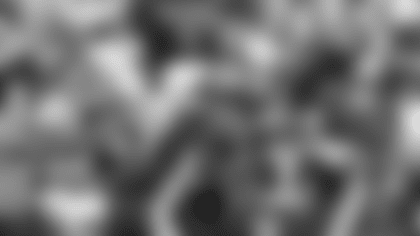Wide Receivers
1. ANTONIO BRYANT
Pittsburgh (6-2, 191; 4.50)
Strengths: Super hands, frame and football speed. Able to gain separation despite lacking great jets. Polished WR who runs precise routes and is very difficult to stay with one-on-one. Fine run-after-catch (RAC) skills and adjusts to the deep ball as well as anyone in this draft. Very productive when healthy and is a fluid, natural athlete. Like Randy Moss, has a knack for getting behind DBs and making the big play. Kick-return ability a big plus.
Weaknesses: May be a bit immature and must show that he will work hard every play, as he tended to take a few plays off occasionally. Cleared of an off-the-field incident before the 2001 season. Sprained his ankle on the first play in 2001 and missed a lot of time.
Bottom Line: Blue-chipper who possesses special receiving skills, which leads us to believe Bryant will be a standout WR by his second season in the league.
2. DONTE STALLWORTH
Tennessee (6-1, 192; 4.30)
Strengths: Excellent speed and awesome RAC skills, making him one of the best big-play WRs in this draft. Not only is he quick off the line, he runs as hard as any WR we've seen with the ball in his hands. Can really push CBs off him and possesses awesome acceleration out of his cuts.
Weaknesses: Average route-runner and is a bit light, needing to gain a solid 10-15 pounds without losing any speed or quickness. Good hands but will get one catch off his body on occasion.
Bottom Line: Still a bit raw, but his upside is tremendous due to his outstanding quickness, speed and acceleration.
3. MARQUISE WALKER
Michigan (6-3, 214; 4.65)
Strengths: Prototype size, very physical blocker and great confidence in his ability. Tremendous acrobatic ability and athleticism, possessing great body control in the air and makes more circus-like, one-handed grabs than anyone in the country. Really wants the ball every pass — playing with a Michael Irvin-like approach to the position — and feels like he can make every play, regardless of coverage.
Weaknesses: Not real quick off the line, a step slow and will get caught from behind in the open field. Still drops too many easy ones and will body-catch and bobble balls at times.
Bottom Line: While a lack of top speed and quickness prevent him from being a true blue-chip prospect, he's got everything else you could look for, including prototype size, strength, hands and understanding of the position — which can't be underestimated. Should be very good for a long time.
4. JABAR GAFFNEY
Florida (6-1, 195; 4.53)
Strengths: Good frame, super hands and great route-runner. Just a third-year sophomore, was unbelievably productive during his two-year stay with the Gators. Fine leaping ability and can out-duel CBs for jump ball and high throws. Does a very good job of positioning his body correctly between the ball and DB and making plays. Very smooth in and out of his cuts and really understands the intricacies of the position, possessing a knack for getting behind CBs.
Weaknesses: Isn't a real burner and can be caught from behind. Needs to add weight. As with previous Gators WRs with comparable measurables, you have to wonder how much of his success is system and how much is skill. Has not displayed the ability to block.
Bottom Line: Tremendous collegiate performer who should challenge for a starting position from day one.
5. JAVON WALKER
Florida State (6-3, 207; 4.46)
Strengths: Possesses all the physical attributes you're looking for in a superstar WR and has been compared to the Vikings Randy Moss. Super hands — can catch the ball with one hand when needed. Very good footwork and is a fluid athlete who, last spring, clocked a remarkable 4.37 (according to FSU). Battles hard on jump balls and will come down with nice catches in traffic.
Weaknesses: While he possesses big, soft hands, he must improve his consistency in catching the ball on the first try. Doesn't play as fast as his listed speed and is not particularly quick getting off the line as he's more of a long strider.
Bottom Line: Underrated big-play WR who, on occasion, can take over contests. With a little refinement, could develop into one of the more feared deep-threats in the league.
6. ASHLEY LELIE
Hawaii (6-3, 179; 4.43)
Strengths: On a given day, can look absolutely unstoppable. Prototype frame with tremendous hands, excellent speed and quickness. Catches the ball with his hands and adjusts well to the poorly thrown balls. Shows fine concentration going over the middle and the burst going in and out of his cuts you look for. A big-league deep threat who also can work the underneath stuff.
Weaknesses: Very thin and his lack of bulk could cause big problems getting off the jam at the line. Put up gargantuan numbers against mainly sub-par competition.
Bottom Line: Playmaker in the truest form of the word. The only thing that keeps us from giving him a true blue-chip grade is his lack of weight and strength.
7. ANDRE DAVIS
Virginia Tech (6-1, 198; 4.32)
Strengths: Tremendous speed (three-time conference 100M champion). Super deep threat, using his blazing speed, acceleration, height and great leaping ability to out-duel DBs. One of the greatest punt return men we've seen, averaging nearly 22 yards per return in 2000, including three TDs.
Weaknesses: Undisciplined route-runner — often rounding off his routes in order to get downfield faster. Still catches the ball with his body at times and bobbles the ball too often. Never put together that super productive season and his durability is a concern.
Bottom Line: Injuries have prevented Davis from becoming the elite prospect we once envisioned, but his world class speed is something to behold.
8. JOSH REED
LSU (5-10, 200; 4.57)
Strengths: Tremendous athleticism and is a big-play threat. A converted RB, he possesses excellent RAC ability (one of the best in this draft) and is an excellent tackle-breaker. His quickness and darting bursts enable him to gain separation from faster players. Fine acceleration and does a good job of getting behind DBs. Unbelievably productive, his lower-body strength and quickness is what separates him from most prospects.
Weaknesses: Average size and speed and may not be a No. 1 WR at the next level, appearing more suited for the big-play secondary threat in the NFL.
Bottom Line: Will likely be drafted higher than our ratings indicate, but we're not sold on Reed becoming a big-time No. 1 WR. Should have a very productive career.
9. RECHE CALDWELL
Florida (6-0, 199; 4.38)
Strengths: Tremendous speed, acceleration and RAC skills. Regarded as the fastest player on a team loaded with speed. Can really stretch the field like few others and averaged high yards per catch. Kick- and punt-return experience a big plus.
Weaknesses: A bit thin and must gain strength as bigger, stronger CBs can push him off his routes. Not much of a blocker and could have used another year in college.
Bottom Line: Real speed demon who, had he returned for his senior season, could have become one of the premier WR prospects in the 2003 draft.
10. KELLY CAMPBELL
Georgia Tech (5-10, 168; 4.33)
Strengths: Tremendous quickness, acceleration and go-the-distance speed. Tough and will take the hits and hold onto the ball. Can make defenders miss in the open field.
Weaknesses: Very, very small and press coverage by NFL CBs could neutralize him getting off the line so quickly. Average route-runner and will drop an easy one on occasion.
Bottom Line: Campbell has a great understanding of the position and possesses some real jets. Similar in many ways to Santana Moss, who went in the first round last year to the New York Jets.















